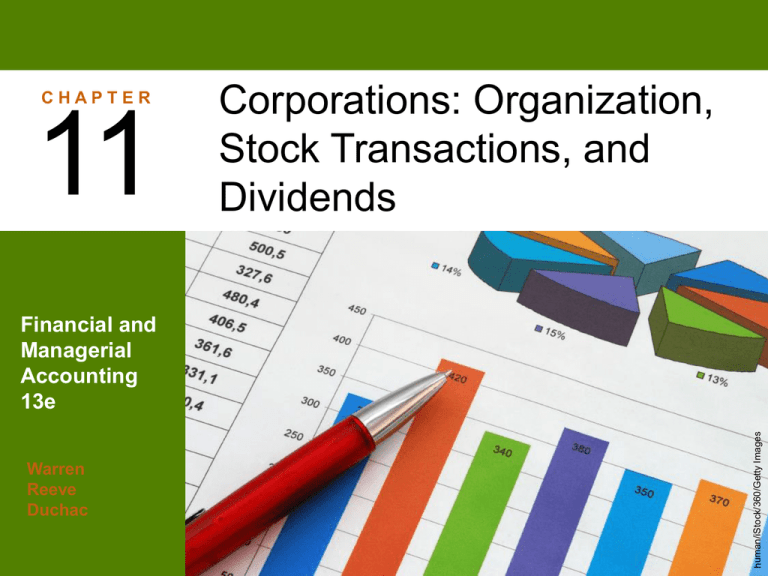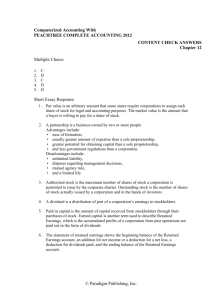
CHAPTER
11
Corporations: Organization,
Stock Transactions, and
Dividends
Warren
Reeve
Duchac
human/iStock/360/Getty Images
Financial and
Managerial
Accounting
13e
Characteristics of a Corporation
(slide 1 of 2)
•
A corporation is a legal entity, distinct and separate
from the individuals who create and operate it.
o
o
o
•
•
As a legal entity, a corporation may acquire, own, and
dispose of property in its own name.
It may also incur liabilities and enter into contracts.
Most importantly, it can sell shares of ownership, called
stock.
The stockholders or shareholders who own the stock
own the corporation.
Corporations whose shares of stock are traded in
public markets are called public corporations.
©2016 Cengage Learning. All Rights Reserved. May not be scanned, copied or duplicated, or posted to a publicly accessible website, in whole or in part.
Characteristics of a Corporation
(slide 2 of 2)
• The stockholders of all corporations have limited
•
•
liability.
The stockholders control a corporation by electing a
board of directors.
As a separate entity, a corporation is subject to taxes.
o
o
Corporations must pay federal income taxes on their
income.
Stockholders must pay income taxes on the dividends they
receive.
©2016 Cengage Learning. All Rights Reserved. May not be scanned, copied or duplicated, or posted to a publicly accessible website, in whole or in part.
Forming a Corporation
•
•
The first step in forming a corporation is to file an application
of incorporation with the state.
After the application has been approved, the state grants a
charter or articles of incorporation.
o
•
•
The articles of incorporation formally create the corporation.
The corporate management and board of directors then
prepare a set of bylaws, which are the rules and procedures
for conducting the corporation’s affairs.
Costs may be incurred in organizing a corporation. These costs
are debited to an expense account entitled Organizational
Expenses.
©2016 Cengage Learning. All Rights Reserved. May not be scanned, copied or duplicated, or posted to a publicly accessible website, in whole or in part.
Characteristics of Stock
(slide 1 of 2)
•
•
•
•
•
The number of shares of stock that a corporation is
authorized to issue is stated in its charter.
The term issued refers to the shares issued to the
stockholders.
The stock remaining in the hands of stockholders is
then called outstanding stock.
Shares of stock are often assigned a dollar amount,
called par value.
Stock issued without par is called no-par stock.
©2016 Cengage Learning. All Rights Reserved. May not be scanned, copied or duplicated, or posted to a publicly accessible website, in whole or in part.
Characteristics of Stock
(slide 2 of 2)
•
•
Some state laws require corporations to maintain a
minimum amount of paid-in capital to protect
creditors. This minimum amount, called legal capital,
usually includes the par or stated value of the shares
issued.
The major rights that accompany ownership of a share
of stock are as follows:
o
o
o
The right to vote in matters concerning the corporation.
The right to share in distributions of earnings.
The right to share in assets upon liquidation.
©2016 Cengage Learning. All Rights Reserved. May not be scanned, copied or duplicated, or posted to a publicly accessible website, in whole or in part.
Classes of Stock
(slide 1 of 2)
•
The two primary classes of paid-in capital are
common stock and preferred stock.
o
o
•
•
When only one class of stock is issued, it is called common
stock. Each share of common stock has equal rights.
When a corporation issues classes of stock with various
preference rights, such a stock is called preferred stock.
Preferred stockholders have first rights (preference) to
any dividends. However, a corporation cannot
guarantee dividends even to preferred stockholders.
The payment of dividends is authorized by the
corporation’s board of directors. When authorized,
the directors are said to have declared a dividend.
©2016 Cengage Learning. All Rights Reserved. May not be scanned, copied or duplicated, or posted to a publicly accessible website, in whole or in part.
Classes of Stock
(slide 2 of 2)
•
Cumulative preferred stock has a right to receive
regular dividends that were not declared (paid) in
prior years.
o
o
•
Noncumulative preferred stock does not have this right.
Cumulative preferred stock dividends that have not been
paid in prior years are said to be in arrears.
In addition to dividend preference, preferred stock
may be given preferences to assets if the corporation
goes out of business and is liquidated. However,
claims of creditors must be satisfied first.
©2016 Cengage Learning. All Rights Reserved. May not be scanned, copied or duplicated, or posted to a publicly accessible website, in whole or in part.
Issuing Stock
(slide 1 of 2)
•
Assume that a corporation is authorized to issue
10,000 shares of $100 preferred stock and 100,000
shares of $20 par common stock. The corporation
issued 5,000 shares of preferred stock and 50,000
shares of common stock at par for cash. The
corporation’s entry to record the stock issue is as
follows:
©2016 Cengage Learning. All Rights Reserved. May not be scanned, copied or duplicated, or posted to a publicly accessible website, in whole or in part.
Issuing Stock
(slide 2 of 2)
•
If the stock is issued (sold) for a price that is more than
its par, the stock has been sold at a premium.
o
•
When stock is issued at a premium, Cash is debited for the
amount received. Common Stock or Preferred Stock is
credited for the par amount. An account entitled Paid-In
Capital in Excess of Par is credited for the excess of the
amount paid over par.
If the stock is issued (sold) for a price that is less than
its par, the stock has been sold at a discount.
©2016 Cengage Learning. All Rights Reserved. May not be scanned, copied or duplicated, or posted to a publicly accessible website, in whole or in part.
Premium on Stock
•
When stock is issued in exchange for assets other than
cash, such as land, buildings, and equipment, the
assets acquired are recorded at their fair market
value.
o
If this value cannot be determined, the fair market value of
the stock issued is used.
©2016 Cengage Learning. All Rights Reserved. May not be scanned, copied or duplicated, or posted to a publicly accessible website, in whole or in part.
No-Par Stock
•
•
When no-par stock is issued, Cash is debited and
Common Stock is credited for the proceeds. As no-par
stock is issued over time, this entry is the same even if
the issuing price varies.
In some states, no-par stock may be assigned a stated
value per share.
o
The stated value is recorded like a par value.
©2016 Cengage Learning. All Rights Reserved. May not be scanned, copied or duplicated, or posted to a publicly accessible website, in whole or in part.
Cash Dividends
(slide 1 of 3)
•
•
•
A cash distribution of earnings by a corporation to its
stockholders is a cash dividend.
Although dividends may be paid in other assets, cash
dividends are most common.
Three conditions for a cash dividend are as follows:
o
o
o
Sufficient retained earnings
Sufficient cash
Formal action by the board of directors
©2016 Cengage Learning. All Rights Reserved. May not be scanned, copied or duplicated, or posted to a publicly accessible website, in whole or in part.
Cash Dividends
(slide 2 of 3)
•
Three dates included in a dividend announcement are
as follows:
1.
Date of declaration
The date of declaration is the date the board of directors formally
authorizes the payment of the dividend.
2.
Date of record
The date of record is the date the corporation uses to determine
which stockholders will receive the dividend.
3.
Date of payment
The date of payment is the date the corporation will pay the
dividend to the stockholders who owned the stock on the date of
record.
©2016 Cengage Learning. All Rights Reserved. May not be scanned, copied or duplicated, or posted to a publicly accessible website, in whole or in part.
Cash Dividends
(slide 3 of 3)
• On October 1, the declaration date, Hiber Corporation records the
following entry:
• On November 10, the date of record, no entry is necessary as this date
•
merely determines which stockholders will receive the dividends.
On December 2, the date of payment, Hiber Corporation records the
payment of the dividends as follows:
©2016 Cengage Learning. All Rights Reserved. May not be scanned, copied or duplicated, or posted to a publicly accessible website, in whole or in part.
Stock Dividends
(slide 1 of 3)
•
•
•
•
•
A stock dividend is a distribution of shares of stock to
stockholders.
Stock dividends normally are declared only on
common stock and issued to common stockholders.
A stock dividend affects only stockholders’ equity.
A stock dividend does not change the assets,
liabilities, or total stockholders’ equity of a
corporation.
Likewise, a stock dividend does not change an
individual stockholder’s proportionate interest (equity)
in the corporation.
©2016 Cengage Learning. All Rights Reserved. May not be scanned, copied or duplicated, or posted to a publicly accessible website, in whole or in part.
Stock Dividends
(slide 2 of 3)
•
The entry to record the stock dividend is as follows:
• At the end of the accounting period, the stock dividends account
is closed to Retained Earnings, and the stock dividends
distributable and paid-in capital in excess of par—common
stock accounts are reported in the Paid-In Capital section of the
balance sheet.
o
Thus, the effect of the preceding stock dividend is to transfer
$3,100,000 of retained earnings to paid-in capital.
©2016 Cengage Learning. All Rights Reserved. May not be scanned, copied or duplicated, or posted to a publicly accessible website, in whole or in part.
Stock Dividends
(slide 3 of 3)
•
On January 10, the stock dividend is distributed to
stockholders by issuing 100,000 shares of common
stock. The issuance of the stock is recorded by the
following entry:
©2016 Cengage Learning. All Rights Reserved. May not be scanned, copied or duplicated, or posted to a publicly accessible website, in whole or in part.
Treasury Stock Transactions
•
•
•
Treasury stock is stock that a corporation has issued
and then reacquired.
Using the cost method, Treasury Stock is debited for
the cost (purchase price) of the stock. When the stock
is resold, Treasury Stock is credited for its cost. Any
difference between the cost and the selling price is
debited or credited to Paid-In Capital from Sale of
Treasury Stock.
No dividends (cash or stock) are paid on the shares of
treasury stock.
©2016 Cengage Learning. All Rights Reserved. May not be scanned, copied or duplicated, or posted to a publicly accessible website, in whole or in part.
Stockholders’ Equity on the Balance Sheet
•
Two methods can be used for reporting stockholders’
equity on the balance sheet:
o
o
Method 1. Each class of stock is reported, followed by its
related paid-in capital accounts. Retained earnings is then
reported, followed by a deduction for treasury stock.
Method 2. The stock accounts are reported, followed by the
paid-in capital reported as a single item, Additional paid-in
capital. Retained earnings is then reported, followed by a
deduction for treasury stock.
©2016 Cengage Learning. All Rights Reserved. May not be scanned, copied or duplicated, or posted to a publicly accessible website, in whole or in part.
Reporting Retained Earnings
•
Changes to retained earnings may be reported using
one of the following:
o
o
o
Separate retained earnings statement
Combined income and retained earnings statement
Statement of stockholders’ equity
©2016 Cengage Learning. All Rights Reserved. May not be scanned, copied or duplicated, or posted to a publicly accessible website, in whole or in part.
Restrictions
•
•
•
The use of retained earnings for payment of
dividends may be restricted by action of a
corporation’s board of directors.
Such restrictions, sometimes called appropriations,
remain part of the retained earnings.
Restrictions of retained earnings are classified as:
o
o
o
Legal. State laws may require a restriction of retained earnings.
Contractual. A corporation may enter into contracts that require
restrictions of retained earnings.
Discretionary. A corporation’s board of directors may restrict retained
earnings voluntarily.
©2016 Cengage Learning. All Rights Reserved. May not be scanned, copied or duplicated, or posted to a publicly accessible website, in whole or in part.
Prior Period Adjustments
•
•
The effect of errors that may arise from a
mathematical mistake or from a mistake in applying
accounting principles that are not discovered within
the same period in which they occur should not affect
the current period’s net income.
Instead, the correction of the error, called a prior
period adjustment, is reported in the retained
earnings statement as an adjustment to the beginning
balance of retained earnings.
©2016 Cengage Learning. All Rights Reserved. May not be scanned, copied or duplicated, or posted to a publicly accessible website, in whole or in part.
Statement of Stockholders’ Equity
•
•
When the only change to stockholders’ equity is due
to net income or net loss and dividends, a retained
earnings statement is sufficient.
However, when a corporation also has changes in
stock and paid-in capital accounts, a statement of
stockholders’ equity is normally prepared.
©2016 Cengage Learning. All Rights Reserved. May not be scanned, copied or duplicated, or posted to a publicly accessible website, in whole or in part.
Stock Splits
•
•
•
A stock split is a process by which a corporation
reduces the par or stated value of its common stock
and issues a proportionate number of additional
shares.
A major objective of a stock split is to reduce the
market price per share of the stock.
Only the number of shares and the par value per
share have changed.
©2016 Cengage Learning. All Rights Reserved. May not be scanned, copied or duplicated, or posted to a publicly accessible website, in whole or in part.
Financial Analysis and Interpretation:
Earnings per Share
•
Earnings per common share (EPS), sometimes called
basic earnings per share, is the net income per share
of common stock outstanding during a period.
•
Earnings per share is computed as follows:
Net Income – Preferred Dividends
Earnings per Share =
Average Number of Common Shares Outstanding
©2016 Cengage Learning. All Rights Reserved. May not be scanned, copied or duplicated, or posted to a publicly accessible website, in whole or in part.









